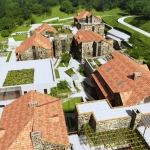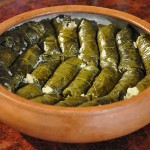“I do not know if I will write a novel about Armenia, but Armenia wrote a novel in my heart.” These words belong to the international best – selling author Paulo Coelho, who was much impressed visiting Armenia in October 2004. When he was asked about his impressions of the city, he said that the buildings and the streets are almost the same everywhere around the world. “It is the people that make the difference, and my best impression was the people.” One of the world’s oldest civilizations, Armenia once included Mount Ararat, which biblical tradition identifies as the mountain that Noah’s ark rested on after the flood. Armenia dates back as far as the sixth century B.C., ori-ginating in the cradle of civilization, the Euphrates valley, and spreading to Asia Minor, in which it became the successor to Urartu in the eighth century B.C. Once spanning the Caucasus region from the Caspian Sea to the Mediterranean, Armenia has maintained its distinctive culture and unique people, despite the numerous conquests over time – from Alexander the Great to the Syrians, Persians, Byzantines, Mongols, and many more.
Throughout most of its long history, however, Armenia has been invaded by a succession of empires. Under constant threat of domination by the foreign forces, Armenians became the fierce protectors of their culture and tradition. But the most horrific massacre took place in April 1915 during World War I, when the Young Turks of the Ottoman Empire ordered the deportation of the Armenian population to the deserts According to the majority of the historians, between 600,000 and 1.5 million Armenians were murdered or died of starvation. The Armenian massacre is considered to be the first genocide in the 20th century. Armenia is also known as the first country in the world, officially adopting Christianity as the only state religion in 301 AD. The Armenian king Trdat was miraculously healed by St. Gregory the Illuminator and declared Christianity as the only official religion -in Armenia. Twelve years later, after the battle of the Milvian Bridge the Roman emperor Constantine would declare Christianity as a tolerable religion in the Roman Empire. Nowadays Armenia occupies a territory of 29, 800 square kilometers. The average altitude of the territory is 1,800 meters above the sea level, the highest peak has an altitude of 4,090 meters and the lowest point is ravine of Debet with an altitude of 380 meters. Armenia occupies a part in the chain of the mountains which is called the Armenian Plateau. While flying in a plane over the Armenian Plateau one can see an endless chain of mountains, lakes hidden in the heights, mountain torrents and waterfalls, valleys, isolated highlands. Among all these, Lake Sevan unveils itself with constantly changing colors – either matching the sky in a harmony or contrasting itself to the blue sky. In the mountains chiseled by the thick forests or deep ravines you can find scattered but interconnected by some inner logic architectural masterpieces like ensemble of Haghartsin monastery (10-13A.D.), Goshavank (10-13 A.D.), Kecharis (11-20A.D.), the complexes of Sanahin and Haghpat (10-20A.D.), Odzun (6-7 A.D.), Marmashen (9-13 A.D.), Hnevank (12-13A.D.).
You can climb through the paths to the fortresses Amberd (7-15 A.D.), Halidzor (17A.D.), Baghaberd (5 A.D.), Garni and you will feel the spirit of centuries, the flight of the human thought and the power of its domination over the nature. This country of lakes, rivers and springs is also rich of mineral waters. In Jermuk, Bjni, Dilijan and other resorts you can treat different diseases by taking a bath in mineral waters. The waterfall of Shaki is one of the aquatic beauties of Armenia, which, splitting the chest of cliffs, falls from an altitude of 18 meters into the ravine and flows into the river Vorotan which passes through Syunik and joins the river Araks. Armenia is beautiful not only in summer but in winter as well when the mountains and valleys are covered with snow. In Tsakhkadzor you can go up to the top of Mount Teghenis by the aerial cable way, contemplate the magnificence of the highland, have a cup of oriental coffee prepared on hot sand and ski down the mountains The capital Yerevan is nice with its old andnew buildings, broad streets, large and small museums and exhibitions. Due to a number of works made during the latest years Yerevan has thoroughly changed its scene. New buildings, new constructions are corroborative evidence of flourishing Yerevan which is also a big importance for tourism promotion.
Armenian Highland
Back To Top










